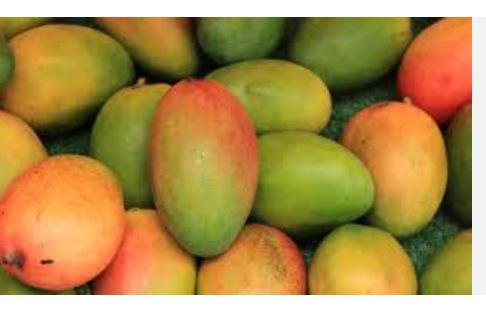
Kent mangoes are classified under Mangifera indica, a species within the Anacardiaceae family, which includes cashews and poison ivy. Native to South Asia, this tropical evergreen has been cultivated for thousands of years, giving rise to diverse cultivars like Kent. As a stone fruit, it fits into the broader mango lineage, admired for its juicy, single-seeded drupes adapted to warm climates.
The Kent mango originated in South Florida, USA, in the 1930s. It was developed by David Sturrock, a horticulturist in Coconut Grove, who planted seeds from a ‘Brooks’ mango tree purchased from a Jamaican grower. One seedling, first fruiting in 1945, stood out for its quality and was named after Sturrock’s neighbor, LeRoy Kent. Grafted and promoted for its flavor and shipping resilience, it gained traction by the 1950s, eventually becoming a commercial staple in the U.S., Latin America, and beyond, prized for its consistent yields and market appeal.
Kent mangoes are large, often weighing 20–26 ounces, with an oval, slightly plump shape. Their thick skin ripens from green to a subtle yellow with a faint red or orange blush, less flashy than some varieties. The flesh is deep orange, juicy, and nearly fiber-free, encasing a medium-sized pit. Their taste is lush and sweet, with a velvety texture and mild peach-apricot notes, balanced by a gentle tartness. Rich and aromatic, they’re a top pick for those seeking a classic, full-bodied mango experience.
Kent mangoes offer robust nutrition. A cup (about 165 grams) delivers around 100 calories, with ample vitamin C for immune and skin health, and vitamin A for vision support. They provide 3 grams of fiber for digestion, plus potassium, magnesium, and folate for heart and energy functions. Antioxidants like quercetin and beta-carotene help reduce inflammation, while digestive enzymes assist metabolism. Their sap and skin, however, may irritate some due to urushiol, a compound shared with family relatives like poison ivy.
Kent mango trees prosper in USDA Hardiness Zones 10–11, requiring tropical or subtropical conditions with temperatures above 40°F (4°C) and ideally 70–95°F (21–35°C). They need full sun and a climate with a dry season to spark flowering, followed by humidity for fruit growth. In the U.S., they’re grown in South Florida, parts of California, and Hawaii. Frost-sensitive, they demand protection in cooler zones, often via greenhouses or containers, making them a challenge outside their sweet spot.
Culinary Applications of Kent Mangoes
- Fresh Eating: Sliced or cubed, their rich, velvety flesh is a standout snack, bursting with tropical sweetness.
- Smoothies: Blended with coconut water or yogurt, they create a thick, luscious drink with a peach-like depth.
- Salsas: Chopped with jalapeño, cilantro, and lime, they add a sweet-spicy lift to grilled meats or tortilla chips.
- Desserts: Pureed into ice cream or layered in trifles, their vibrant flavor elevates sweets effortlessly.
- Salads: Diced into mixed greens or fruit medleys, they bring a juicy, colorful contrast to nuts or cheese.
- Grilling: Halved and lightly charred, they pair beautifully with pork or shrimp, caramelizing for extra richness.
- Chutneys: Simmered with vinegar and spices, their sweetness balances tangy, savory spreads for curries or roasts.
- Juices: Pressed or blended, they yield a thick, aromatic juice perfect solo or mixed into cocktails.
Cultivation of Kent Mangoes
- Climate: Kent Mangoes demand a tropical or subtropical climate, thriving in temperatures of 70–95°F (21–35°C), with a dry season (2–3 months) to initiate flowering and humid conditions for fruit development.
- Soil: They prefer well-drained, loamy or sandy loam soils with a pH of 5.5–7.0, rich in organic matter; poor drainage can lead to root rot, a frequent issue for this variety.
- Propagation: Grafting onto sturdy rootstocks like ‘Turpentine’ or ‘Keitt’ is standard, preserving Kent’s traits and accelerating fruiting (within 3–5 years) versus seed propagation, which is rarely used.
- Planting: Trees are spaced 25–35 feet (7.5–10.5 meters) apart, planted during the rainy season in holes amended with compost to boost early growth and root establishment.
- Irrigation: Young trees require regular watering (1–2 times weekly) for the first few years; mature trees depend on seasonal rains, with supplemental irrigation during drought to prevent fruit drop.
- Pruning: Light pruning post-harvest removes dead wood, shapes the canopy for sunlight penetration, and keeps trees at 12–18 feet (3.6–5.5 meters) for manageable harvests.
- Fertilization: A balanced fertilizer (e.g., 8-3-9) is applied 2–3 times yearly, with extra potassium and magnesium to support fruit quality; over-fertilizing can worsen disease susceptibility.
- Flowering: Triggered by a dry period or cool nights (50–60°F or 10–15°C), flowering peaks in late winter to early spring, relying on bees and wind for pollination, though yields can be erratic.
- Fruiting: Fruits mature in 100–130 days, ripening from June to August in the Northern Hemisphere; a mature tree (8–10 years) may yield 150–300 mangoes, though biennial bearing is common.
- Pest Management: Susceptible to anthracnose, powdery mildew, and mango hoppers, they need vigilant care—fungicides (e.g., sulfur) and insecticidal soaps are applied, especially pre-bloom and post-rain.
- Harvesting: Fruits are hand-picked when mature but firm (green with a slight blush), using clippers to minimize sap damage; they ripen off-tree in warm, controlled conditions.
- Yield Challenges: Haden’s disease sensitivity (notably anthracnose) and inconsistent fruiting require meticulous management—orchards often thin blooms or use growth regulators to stabilize production.